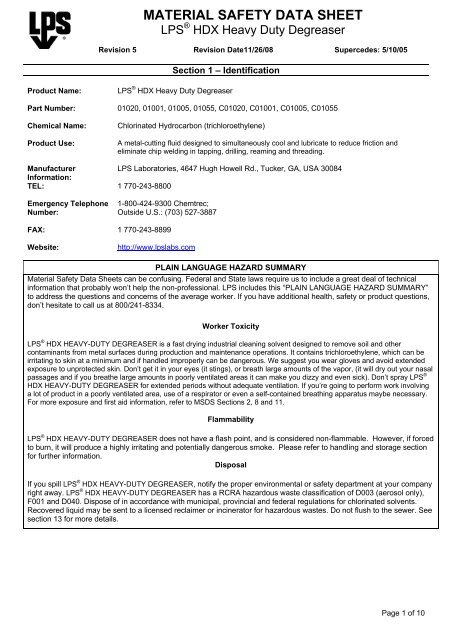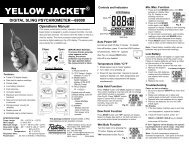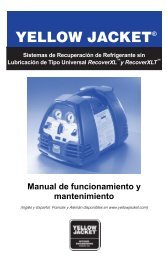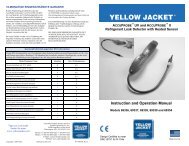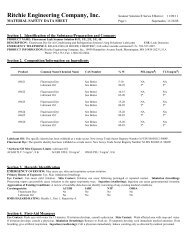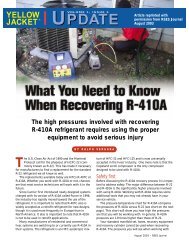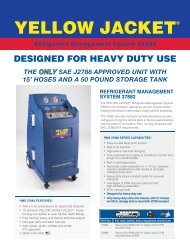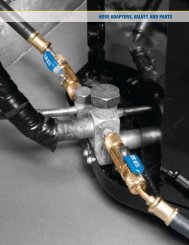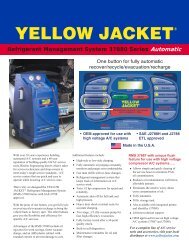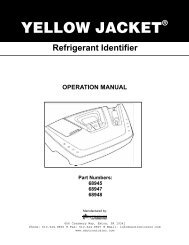LPS HDX Heavy Duty Degreaser 69698 - Yellow Jacket
LPS HDX Heavy Duty Degreaser 69698 - Yellow Jacket
LPS HDX Heavy Duty Degreaser 69698 - Yellow Jacket
You also want an ePaper? Increase the reach of your titles
YUMPU automatically turns print PDFs into web optimized ePapers that Google loves.
MATERIAL SAFETY DATA SHEET<strong>LPS</strong> ® <strong>HDX</strong> <strong>Heavy</strong> <strong>Duty</strong> <strong>Degreaser</strong>Revision 5 Revision Date11/26/08 Supercedes: 5/10/05Section 1 – IdentificationProduct Name:Part Number:Chemical Name:Product Use:<strong>LPS</strong> ® <strong>HDX</strong> <strong>Heavy</strong> <strong>Duty</strong> <strong>Degreaser</strong>01020, 01001, 01005, 01055, C01020, C01001, C01005, C01055Chlorinated Hydrocarbon (trichloroethylene)A metal-cutting fluid designed to simultaneously cool and lubricate to reduce friction andeliminate chip welding in tapping, drilling, reaming and threading.Manufacturer<strong>LPS</strong> Laboratories, 4647 Hugh Howell Rd., Tucker, GA, USA 30084Information:TEL: 1 770-243-8800Emergency TelephoneNumber:1-800-424-9300 Chemtrec;Outside U.S.: (703) 527-3887FAX: 1 770-243-8899Website:http://www.lpslabs.comPLAIN LANGUAGE HAZARD SUMMARYMaterial Safety Data Sheets can be confusing. Federal and State laws require us to include a great deal of technicalinformation that probably won’t help the non-professional. <strong>LPS</strong> includes this “PLAIN LANGUAGE HAZARD SUMMARY”to address the questions and concerns of the average worker. If you have additional health, safety or product questions,don’t hesitate to call us at 800/241-8334.Worker Toxicity<strong>LPS</strong> ® <strong>HDX</strong> HEAVY-DUTY DEGREASER is a fast drying industrial cleaning solvent designed to remove soil and othercontaminants from metal surfaces during production and maintenance operations. It contains trichloroethylene, which can beirritating to skin at a minimum and if handled improperly can be dangerous. We suggest you wear gloves and avoid extendedexposure to unprotected skin. Don’t get it in your eyes (it stings), or breath large amounts of the vapor, (it will dry out your nasalpassages and if you breathe large amounts in poorly ventilated areas it can make you dizzy and even sick). Don’t spray <strong>LPS</strong> ®<strong>HDX</strong> HEAVY-DUTY DEGREASER for extended periods without adequate ventilation. If you’re going to perform work involvinga lot of product in a poorly ventilated area, use of a respirator or even a self-contained breathing apparatus maybe necessary.For more exposure and first aid information, refer to MSDS Sections 2, 8 and 11.Flammability<strong>LPS</strong> ® <strong>HDX</strong> HEAVY-DUTY DEGREASER does not have a flash point, and is considered non-flammable. However, if forcedto burn, it will produce a highly irritating and potentially dangerous smoke. Please refer to handling and storage sectionfor further information.DisposalIf you spill <strong>LPS</strong> ® <strong>HDX</strong> HEAVY-DUTY DEGREASER, notify the proper environmental or safety department at your companyright away. <strong>LPS</strong> ® <strong>HDX</strong> HEAVY-DUTY DEGREASER has a RCRA hazardous waste classification of D003 (aerosol only),F001 and D040. Dispose of in accordance with municipal, provincial and federal regulations for chlorinated solvents.Recovered liquid may be sent to a licensed reclaimer or incinerator for hazardous wastes. Do not flush to the sewer. Seesection 13 for more details.Page 1 of 10
MATERIAL SAFETY DATA SHEET<strong>LPS</strong> ® <strong>HDX</strong> <strong>Heavy</strong> <strong>Duty</strong> <strong>Degreaser</strong>Revision 5 Revision Date11/26/08 Supercedes: 5/10/05Section 2 – Hazards IdentificationThis material is considered hazardous by the OSHA Hazard Communication Standard (29 CFR 1910.1200).This product has been classified in accordance with the hazard criteria of the Controlled Products Regulations and theMSDS contains all the information required by the Controlled Products Regulations.Emergency Overview:Aerosol: DANGER: Harmful or Fatal if Swallowed. Vapor Harmful. Contents under pressure.Bulk: DANGER: Harmful or Fatal if Swallowed. Vapor Harmful.Primary route(s) of entry: Skin and Eye contact. Inhalation.Potential Acute Health Effects:Eyes:Liquid in eyes produces pain and irritation with mild temporary damage possible. Vapor canirritate eyes.Skin:Inhalation:Ingestion:Prolonged or repeated contact of liquid can cause skin irritation, defatting of skin, and dermatitis.Absorption of liquid through intact skin is possible, causing systemic poisoning, but this is anunlikely route of significant toxic exposure.High concentrations of vapor, in excess of the occupational exposure limit, will lead to adverseeffects on the central nervous system, causing nausea, headaches, dizziness andlightheadedness (concentrations in excess of 300ppm). Higher concentrations, around 5000ppmand above, will cause anesthetic effects, leading to unconsciousness and in extreme cases,coma and death. Very high exposures may cause an abnormal heart rhythm and prove suddenlyfatal.Product has a low order of acute oral toxicity, but ingestion of large quantities may cause nausea,vomiting, and gastrointestinal irritation. May cause injury if aspirated into lungs causing adversehealth effects as described in the inhalation section above.Potential Chronic Health Effects:Carcinogenic Effects: See Section 11NTP: Suspect Carcinogen IARC: Group 2A OSHA: NoMutagenic Effects: Has been linked to mutagenic effects in humans.Teratogenic Effects: Did not cause birth defects in laboratory animals. Has been toxic to the fetus in lab animals atlevels toxic to the mother.Target Organs:In animals, effects have been reported on the following organs: Kidney, Liver, Central nervous system, Peripheralnervous system.Medical conditions aggravated by exposure:Repeated exposure to high levels produces adverse effects on the liver and, to a lesser extent on the kidney. Acondition known as '<strong>Degreaser</strong>'s Flush', a pronounced redness of the skin, may occur on the face, hands, arms, feetand trunk of some individuals following repeated exposure to trichloroethylene and the consumption of alcohol.This effect can intensify over a 30 minute period but usually disappears completely after 1 hour.These symptoms may occur up to 6 weeks after the last exposure to trichloroethylene and can reoccur if exposurecontinues.Interactions with other chemicals which enhance toxicity: Consumption of alcoholic beverages may increasepotential for development of toxic effects resulting from exposure to this product.Signs and Symptoms:Stinging in eyes. Repeated or prolonged skin contact can cause redness, irritation, and scaling of the skin (dermatitis).Breathing of high vapor concentrations may cause headaches, stupor, irritation of throat and eyes, and kidney effects.Page 2 of 10
MATERIAL SAFETY DATA SHEET<strong>LPS</strong> ® <strong>HDX</strong> <strong>Heavy</strong> <strong>Duty</strong> <strong>Degreaser</strong>Revision 5 Revision Date11/26/08 Supercedes: 5/10/05Section 3 – Composition / Information on IngredientsComponent CASRN Weight PercentTrichloroethylene 79-01-6 90 – 100%Carbon Dioxide (aerosol only) 124-38-9 1 – 10%Section 4 – First Aid MeasuresEyes:Skin:Inhalation:Ingestion:Notes toPhysician:Check for and remove contact lenses. If irritation or redness develops, flush eyes with cool, clean, lowpressure water for at least 15 minutes. Hold eyelids apart to ensure complete irrigation of the eye andeyelid tissue. Do not use eye ointment. Seek medical attention immediately.Remove contaminated shoes and clothing. Clean affected area thoroughly with mild soap and water. Donot use ointments. Seek medical attention if irritation persists.Immediately move victim to fresh air. If victim is not breathing, immediately begin rescue breathing. Ifheart has stopped, immediately begin cardiopulmonary resuscitation (CPR). If breathing is difficult, seekmedical attention immediately.Do NOT induce vomiting unless directed to do so by medical personnel. Never give anything by mouthto an unconscious person. If spontaneous vomiting is about to occur, place victim’s head below knees. Ifvictim is drowsy or unconscious, place on the left side with head down. Do not leave victim unattended.Seek medical attention immediately.Chlorinated hydrocarbons may sensitize the heart to epinephrine and other circulating catecholamine’sso that arrhythmias may occur. Careful consideration of this potential adverse effect should precedeadministration of epinephrine or other cardiac stimulants and the selection of bronchodilators.Section 5 – Fire Fighting MeasuresProducts of Combustion: Carbon monoxide, carbon dioxide, chlorine, hydrogen chloride and traces of phosgene.Firefighting media: Use CO 2 , DRY chemical powder, water spray, fog or foam. Cool containing vessels with water jetin order to prevent pressure build-up, auto ignition or explosions.Sensitivity to Impact: None.Sensitivity to Static Discharge: NoneProtection Clothing (Fire): Concentrated vapors can be ignited by high intensity ignition source. Firefighters shouldwear self-contained, positive pressure breathing apparatus and full protective clothing due to thermal decompositionproducts.Special Remarks on Explosion Hazards: Explosive mixtures of trichloroethylene and air can be formed, but aredifficult to ignite and require high intensity sources of heat, such as welding arcs, sparks and flames or hightemperatures and pressures; addition of small amounts of flammable substances to trichloroethylene (such asflammable liquids or gases) and / or an increase in the oxygen content of the local atmosphere, may strongly enhancethese effects. Welding or cutting should not be carried out on any vessel likely to contain solvent because of the risk ofexplosion. Thermal decomposition will evolve toxic and corrosive vapors of hydrogen chloride and phosgene.Containers may burst if overheated due to thermal expansion of the contents.Page 3 of 10
MATERIAL SAFETY DATA SHEET<strong>LPS</strong> ® <strong>HDX</strong> <strong>Heavy</strong> <strong>Duty</strong> <strong>Degreaser</strong>Revision 5 Revision Date11/26/08 Supercedes: 5/10/05Section 6 – Accidental Release MeasuresContainmentProceduresSmall Spill and Leak:Large Spill and Leak:Absorb with an inert material and dispose of properly.Dike far ahead of a liquid spill to ensure complete collection. Pick upfree liquid for disposal using absorbent pads, sand, or other inertnon-combustible absorbent materials. Place into appropriate wastecontainers for later disposal. Do not allow to enter drains, sewers orwaterways. Spillages or uncontrolled discharges into waterwaysmust be alerted to the Environment Agency or other appropriateregulatory body.Clean-UpProceduresEvacuationProceduresSpecialProceduresRecover free product and place in suitable container for disposal. Do not allow to enter drains,sewers or waterways. Spillages or uncontrolled discharges into waterways must be alerted to theEnvironment Agency or other appropriate regulatory body.Ventilate area of leak or spill. Keep unnecessary and unprotected people away.Ventilate area. Wear appropriate protective equipment during cleanup.Section 7 – Handling and StorageHandling: Do not breathe vapor. Use only in well ventilated areas. Avoid contact with skin and eyes.Avoid contact with naked flames and hot surfaces as toxic and corrosive decomposition products (hydrogen chloride)can be formed. The vapor is heavier than air and may reach dangerously high concentrations in pits, tanks, and otherconfined spaces. In such cases provide adequate ventilation or wear suitable respiratory protective equipment withpositive air supply. When using, do not smoke. When welding metals degreased with trichloroethylene, special care isneeded to ensure all solvent has evaporated from the components. Separate cleaning and welding areas. Ensurevapors from degreasing operations do not enter welding areas - welding arcs can cause trichloroethylene vapors tobreak down producing toxic vapors.Storage: Keep container dry. Keep in a cool, well ventilated place. Keep away from direct sunlight. Keep away fromheat and sources of ignition.Exposure Guidelines:Section 8 – Exposure Controls / Personal ProtectionComponent CASRN OSHA TWA-PEL OSHA STEL ACGIH-TLV ACGIH-STEL NIOSH RELTrichloroethylene 79-01-6 100 ppm 200 ppm 50 ppm 100 ppmCarbon Dioxide(aerosol only)124-38-9 5000 ppmNotEstablished5000 ppm 30000 ppmNotEstablished5000 ppmTWA30000 ppmSTELPage 4 of 10
MATERIAL SAFETY DATA SHEET<strong>LPS</strong> ® <strong>HDX</strong> <strong>Heavy</strong> <strong>Duty</strong> <strong>Degreaser</strong>Revision 5 Revision Date11/26/08 Supercedes: 5/10/05EngineeringProvide general and/or local exhaust ventilation to keep exposures below the exposuremeasuresguidelines listed above. Lethal concentrations may exist in areas with poor ventilation.Personal protective equipmentEye protectionHand protectionRespiratoryprotectionSafety glasses with side shields conforming to appropriate regulations. Eye wash fountain andemergency shower facilities are recommended.Use laminate gloves chemically resistant to this material and conforming to appropriateregulations. Please observe the instructions regarding permeability and breakthrough time thatare provided by the supplier of the gloves. Take into consideration the specific local conditionsunder which the product is used, such as the danger of cuts, abrasion and the contact time.If airborne concentrations are above the applicable exposure limits (listed above), useNIOSH approved respiratory protection.Section 9 – Physical and Chemical PropertiesAppearance: Clear liquid. Color: Clear, light brownOdor/Taste: Sweet, spice. Evaporation Rate: 0.3 (Ethyl Ether =1)Solubility Description: 0.1% in water Flash Point (°C): NoneOdor Threshold: Not Established Decomposition Temperature: Not EstablishedBoiling Point: 87°C (189°F) Auto Ignition Temperature: >420°C(788°F)Specific Gravity (Water=1): 1.35 @ 20 °C Partition Coefficient(octanol/water):2.4Vapor Density (Air=1): 4.5 Volatiles: 90%Vapor Pressure: 58 mmHg @ 20°C V.O.C. content 87%,1169 g/L, 9.8#/gal perCARB definitionpH: Not applicable Viscosity: 0.391 cStFlammable limits (estimated): LOWER: 8%UPPER:10.5%Melting Point (°C):Not ApplicablePage 5 of 10
MATERIAL SAFETY DATA SHEET<strong>LPS</strong> ® <strong>HDX</strong> <strong>Heavy</strong> <strong>Duty</strong> <strong>Degreaser</strong>Revision 5 Revision Date11/26/08 Supercedes: 5/10/05Section 10 – Chemical Stability and ReactivityChemical Stability:Conditions to Avoid:Product is stable under recommended storage conditions.Keep away from red hot surfaces, sparks or naked flames which may generate toxic fumes ofphosgene and hydrogen chloride. Prolonged contact with aluminum or light alloys may cause areaction resulting in the generation of hydrogen chloride gas and heat.Incompatibility:HazardousDecomposition:HazardousPolymerization:Extremely reactive or incompatible with oxidizing agents. Reacts violently with sodium,potassium, barium metal. Reacts with finely divided aluminum, zinc and magnesium.Combustion will generate smoke, possibly thick and choking, resulting in zero visibility andcombustion products include hydrogen chloride and traces of phosgene gas.Will not occur.Section 11 – Toxicological InformationGeneral Product InformationAcute Toxicity: An acute toxicity study of this product has not been conducted. Information given in this sectionrelates only to individual constituents contained in this preparation.Trichloroethylene: 200 ppm causes mild eye irritation. 400 ppm causes slight eye irritation and minimal lightheadednessafter 3 hours. 1,000 to 1,200 ppm after 6 minutes causes eye and nasal irritation, light-headedness anddizziness. 2,000 ppm cannot generally be tolerated, is irritating to the eyes and respiratory tract and causesdrowsiness, dizziness and nausea within 5 minutes. Ventricular arrhythmias and very rapid respiration have beenobserved in individuals exposed to 15,000 ppm. High concentrations or prolonged overexposure can causeunconsciousness and death.Component AnalysisComponent CASRN LC-50 LD-50Trichloroethylene 79-01-6 12500ppm/4H/rat**Supplier DataCarcinogenicity:NTP: Suspected carcinogen IARC: (2A) probable carcinogen OSHA: No4920 mg/kg/oral/rat*~10000mg/kg/rabbit/dermal*Trichloroethylene has been shown to cause cancer in animals. Mechanistic studies have shown that some of theseobservations are not relevant for humans. Some experts believe that repeated exposure to high concentrations oftrichloroethylene may cause kidney cancer, although the evidence for a causal relationship between these events isfar from conclusive. None of the toxic effects of trichloroethylene will occur provided that exposures are kept belowthe current TLV.The International Agency for Research on Cancer (IARC) has concluded that with respect to trichloroethylene, there issufficient evidence of carcinogenicity to experimental animals and limited evidence of carcinogenicity to humans,resulting in a classification in Group 2A as a substance probably carcinogenic to humans. NTP has classifiedtrichloroethylene as reasonably anticipated to be a human carcinogen.Mutagenicity: Rodent - rat /1000 ppm/4H Brain and Coverings - changes in surface EEG Peripheral Nerve andSensation - sensory syndrome diagnostic of central lesion Sense Organs and Special Senses (Eye) RTECS#KX4550000. Trichloroethylene has been linked to mutagenic effects in humans. Some studies measuring DNAdamage (strand breaks, unscheduled DNA synthesis, in-vitro and in-vivo micronucleus and chromosomal aberrations)have been positive.Page 6 of 10
MATERIAL SAFETY DATA SHEET<strong>LPS</strong> ® <strong>HDX</strong> <strong>Heavy</strong> <strong>Duty</strong> <strong>Degreaser</strong>Revision 5 Revision Date11/26/08 Supercedes: 5/10/05Neurotoxicity: Rodent - rat /1000 ppm/4H Brain and Coverings - changes in surface EEG Peripheral Nerve andSensation - sensory syndrome diagnostic of central lesion Sense Organs and Special Senses (Eye) RTECS#KX4550000.Reproductive Toxicity: Did not cause birth defects in laboratory animals; has been toxic to the fetus in lab animals atlevels toxic to the mother.Note to Physician: Gastric lavage may be effective within four hours of ingestion. Product is an asphyxiant and caninduce cardiac muscular sensitization to circulating epinephrine-like compounds, resulting in potentially fatal heartarrhythmias. Do not give adrenaline or similar sympathomimetic drugs. Do not allow exposed person to exercisevigorously for 24 hours following potentially toxic exposure.Section 12 – Ecological InformationMobility: High mobility in soil and sediment Persistence anddegradability:Not readily biodegradableBioaccumulativepotential:Minimal bioaccumulation potential Other Adverse Effects: See belowOther adverse effects: Harmful to aquatic organisms; may cause long-term adverse effects in the aquaticenvironment. This product has potential for leaching.EnvironmentalFate:EnvironmentalToxicity:When released into the soil, trichloroethylene is expected to quickly evaporate, but large spillshave potential to leach into groundwater. When released to water trichloroethylene will quicklyevaporate, but large spills are expected to be slightly toxic to aquatic life. When released intothe air, trichloroethylene is expected to have a half-life between 1 and 10 days.The LC50/96-hour values for trichloroethylene in fish are between 10 and 100 mg/l.Trichloroethylene has an experimentally-determined bioconcentration factor (BCF) of less than100 and is not expected to significantly bioaccumulate.Ecotoxicology:Effect on Organisms Component CASRN Test Species ResultsAcute Toxicity on Fishes Trichloroethylene 79-01-6 96h-LC 50 Pimephales promelas 41-67 mg/L*Acute Toxicity onDaphniaTrichloroethylene 79-01-6 48h-LC 50 Daphnia magna 2.2-100 mg/L*Bacterial inhibition Trichloroethylene 79-01-6 EC 50 Unidentified microorganism 260 mg/L*Growth inhibition of algae Trichloroethylene 79-01-6 24h-EC 50 Algae 410 mg/L*Bioaccumulation in fish Trichloroethylene 79-01-6 BCF Fish species (unidentified) 17-90** Supplier DataPage 7 of 10
MATERIAL SAFETY DATA SHEET<strong>LPS</strong> ® <strong>HDX</strong> <strong>Heavy</strong> <strong>Duty</strong> <strong>Degreaser</strong>Revision 5 Revision Date11/26/08 Supercedes: 5/10/05Section 13 – Disposal ConsiderationsWaste Status:Disposal:Note:Per 40 CFR 261.7 aerosol versions of this product, if disposed of in its received form, carry wastecode(s) D040 and D003. Per 40 CFR 261.7 (U.S.) bulk versions of this product, if disposed of in itsreceived form, carries waste code D040.Waste must be disposed of in accordance with national, regional, provincial, and local environmentalcontrol regulations.Chemical additions to, processing of, or otherwise altering this material may make this wastemanagement information inaccurate, incomplete, or otherwise inappropriate. Furthermore, state andlocal waste disposal requirements may be more restrictive than federal laws and regulations.Section 14 – Transportation InformationAerosolShipping Name: Consumer Commodity UN Number: 1950D.O.T. GroundRoad/Rail -ADR/RIDIMDG-IMOIATA-ICAOHazard Class: ORM-D Technical Name: N/AORM-DSubclass: N/A Hazard Label:Already onboxUN no:1950ADR Class:2Packing group:NAName andAEROSOLS, toxicDescription:Labeling: 2.2, 6.1UN no:1950Shipping Name:AerosolsClassification code:Hazard ID no:Class: 2Subsidiary Risk:PackingInstructions:P003, LP02 Packing group: NAMarine pollutant: NO EmS: F-D, S-UUN no: 1950 Class: 2.2Shipping Name:Packinginstructions:Labeling:Aerosols. Non-flammable,containing substances indivision 6.1, Packing Group III5TNANASubclass 6.1203, Y203 (Ltd. Qty.) Packing group: IIINon-flammable Gas & ToxicPage 8 of 10
MATERIAL SAFETY DATA SHEET<strong>LPS</strong> ® <strong>HDX</strong> <strong>Heavy</strong> <strong>Duty</strong> <strong>Degreaser</strong>Revision 5 Revision Date11/26/08 Supercedes: 5/10/05BulkD.O.T. GroundRoad/Rail -ADR/RID :IMDG-IMOShipping Name: Trichloroethylene UN Number: 1710Hazard Class: 6.1 Technical Name: N/ASubclass: N/A Hazard Label: 6.1UN no: 1710 ADR Class:Packing group: III Classification code:Name andDescription:Labeling: 6.1UN no:Trichloroethylene1710Hazard ID no:6.1T1N/AClass: 6.1Shipping Name: Trichloroethylene Subsidiary Risk: NAPackingInstructions:P001, LP01 Packing group: IIIMarine pollutant: NO EmS: F-A, S-AUN no: 1710 Class: 6.1IATA-ICAO:Shipping Name: Trichloroethylene Subclass NAPackinginstructions:Labeling:NA Packing group: NANon-flammable GasSection 15 – Regulatory InformationU.S. Federal RegulationsRCRA Hazardous Waste No.: D040, D003 (aerosols only)Comprehensive Environmental Response and Liability Act of 1980 (CERCLA): Trichloroethylene 79-01-6 100 lbsToxic Substances Control Act (TSCA):All components of this product are TSCA inventory listed and/or are exempt.Superfund Amendments and Reauthorization Act (SARA) Title IIISARA Section 311/312 (40 CFR 370) Hazard Categories: Immediate (Acute) Health Hazard, Delayed (Chronic)Health HazardThis product contains the following toxic chemical(s) subject to reporting requirements of SARA Section 313(40 CFR 372): Trichloroethylene 79-01-6Section 112 Hazardous Air Pollutants (HAPs): Trichloroethylene 79-01-6Page 9 of 10
MATERIAL SAFETY DATA SHEET<strong>LPS</strong> ® <strong>HDX</strong> <strong>Heavy</strong> <strong>Duty</strong> <strong>Degreaser</strong>Revision 5 Revision Date11/26/08 Supercedes: 5/10/05State RegulationsCalifornia: This product contains chemical(s) known to the State of California to cause cancer, birth defects orreproductive harm.New Jersey Right to Know:Trichloroethylene 79-01-6 ● 1, 2 Butylene Oxide 106-88-7 ● Methyl Pyrrole 96-54-8 ● Butanone 78-93-3 ●Carbon Dioxide 124-38-9 (aerosol only)International RegulationsCanadian Environmental Protection Act: All of the components of this product are included on the CanadianDomestic Substances list (DSL).Canadian Workplace Hazardous Materials Information System WHMIS:This product has been classified in accordance with the hazard criteria of the Controlled Products Regulations and theMSDS contains all the information required by the Controlled Products Regulations.WHMIS Classification:AerosolClass A, Class D1B, Class D2A, D2BBulkClass D1B, Class D2A, D2BOther RegulationsMontreal Protocol listed ingredients:Stockholm Convention listed ingredients:Rotterdam Convention listed ingredients:RoHS Compliant:None.None.None.Yes.Section 16 • Other InformationMSDS#11020Responsible Name:Clea JohnsonRegulatory Affairs CoordinatorHMIS 1996 HMIS III NFPAHealth: 2 Health: 2*Flammability: 1 Flammability: 1Reactivity 0Physical Hazard: aerosol 2Physical Hazard: bulk 0Flammability21Health 120ReactivityNotice to Reader:To the best of our knowledge, the information contained herein is accurate. However, neither the above named supplier nor any ofits subsidiaries assumes any liability whatsoever for the accuracy or completeness of the information contained herein. Finaldetermination of suitability of any material is the sole responsibility of the user. All materials may present unknown hazards andshould be used with caution. Although certain hazards are described herein, we cannot guarantee that these are the only hazardsthat exist.Clea Johnson, Regulatory Affairs Coordinator<strong>LPS</strong> Laboratories, A division of Illinois Tool WorksPage 10 of 10


